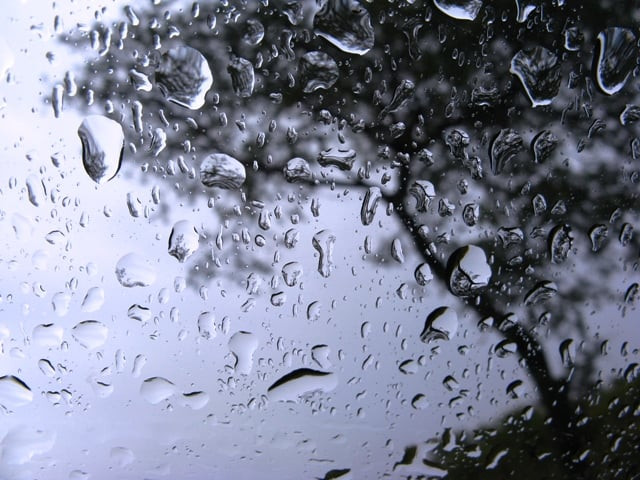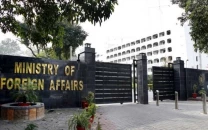Unrelenting rains kill up to 37 more in Sindh, eight in Punjab
Sindh Chief Minister Qaim Ali Shah has announced a grant of Rs5 million to each rain-affected district in the province

As rains and floods continue to lash Sindh, at least 37 people lost their lives across the province on Tuesday while access to hundreds of coastal villages was cut off as several roads were washed away.
Over the past five days, Sindh has been hit by widespread rains with Jacobabad receiving 481mm, Larkana 215mm, Sukkur 206mm, Chhor 137mm, Badin108 mm and Hyderabad and Dadu recording 90mm of rainfall.
Like the past year, monsoon has left many low-lying areas in Shikarpur, Jacobabad, Thull, Kashmore, Kandhkot, Sukkur, Khairpur, and Larkana submerged.
In Kashmore, 17 people, including women and children, were killed as hundreds of katcha houses collapsed when the flash floods hit the area around midnight. According to the Met office, more rains are expected in parts of lower Sindh and southeast Balochistan over the next 24 hours.
Sindh Chief Minister Qaim Ali Shah has announced a grant of Rs5 million to each rain-affected district in the province.
D G Khan
Meanwhile, as floodwaters receded from the badly-hit Dera Ghazi Khan district on Tuesday, four bodies were recovered from Choti Zaireen over the last 48 hours. Small amounts of flooding continued to plague Rajanpur, Rojhan, Jampur and Dera Ghazi Khan.
In addition, another four people died in Rajanpur when a clash broke out between panicked residents trying to divert floodwater from a rural area, Sukhera. Police were unable to reach the spot and intervene in time because ground routes were blocked.
Although D G Khan’s urban area has been drained of water, inundated rural areas are still being cleared out by the district administration in coordination with the flood victims themselves. As many as 50,000 people have returned to the city in the last 24 hours after evacuating earlier. Inter Services Public Relations (ISPR) confirmed that more troops had arrived to rescue people in the flooded regions.
Meanwhile, the D G link canal was in the process of being repaired. Three major breaches have been fixed while the other four are expected to be repaired by today at noon (Wednesday). Agricultural losses are estimated to have affected around 20,000 acres of rice, wheat, cotton, maize and other crops, according to the provincial agricultural minister. Makeshift medical camps have been set up on the National Highway since the major hospitals of the city, including the District Headquarters hospital, remain inundated.
According to district officials, as many as 2,000 houses have been affected in D G Khan, including those which have been completely destroyed – but losses are still building up. Heritage sites, including the mausoleums of Hazrat Bukhari and Jamalallah in Rajanpur, have also been badly damaged.
D G Khan’s tribal area has experienced the biggest devastation, where necessities are being provided via helicopters.
Infuriated residents, however, organised separate protests across the district to demonstrate over not being provided relief items. Demonstrators chanted against political leaders and complained that they needed aid, not statements and visits accompanied by a cohort of security vehicles.
Balochistan
In Balochistan, meanwhile, thousands remain stranded due to the disruption of electricity and communication lines, especially in Naseerabad and Jaffarabad. Blocked routes have led to a massive shortage of food and medicine while crops over thousands of acres have been destroyed and livestock lost. One man drowned in Bolan district’s Machh Nullah.
Moreover, cracks have appeared in the banks of the Pat Feeder canal at five different places which has exacerbated the flooding. The breaches have inundated dozens of low-lying villages, forcing hundreds of families to move to higher ground. The floodwater has also entered the Uch Power Plant due to which half of the plant has been closed, sources told The Express Tribune.
Railway tracks and highways in Jaffarabad and Naseerabad were inundated, cutting off rail links between the province and the rest of Pakistan for the third consecutive day.
While the Provincial Disaster Management Authority (PDMA) has already dispatched some trucks carrying tents and other food items to the affected areas, it is unable to match the needs of the affected people.
“We are stuck in Dera Murad Jamali and there’s water everywhere. We are sitting in the district commissioner’s office in stagnant water that’s two feet deep,” said a PDMA driver talking to The Express Tribune. He added said that some of the PDMA drivers were stranded in Jhal Magsi and contact couldn’t be established with them due to the disruption of phone networks.
According to Inter-Services Public Relation (ISPR) sources, the army has also kicked off relief efforts on a large scale following the orders of the Southern Command.
(WITH ADDITIONAL REPORTING BY MOHAMMAD ZAFAR IN QUETTA)
Published in The Express Tribune, September 12th, 2012.












1726134115-0/BeFunk_-(41)1726134115-0-208x130.webp)






COMMENTS
Comments are moderated and generally will be posted if they are on-topic and not abusive.
For more information, please see our Comments FAQ